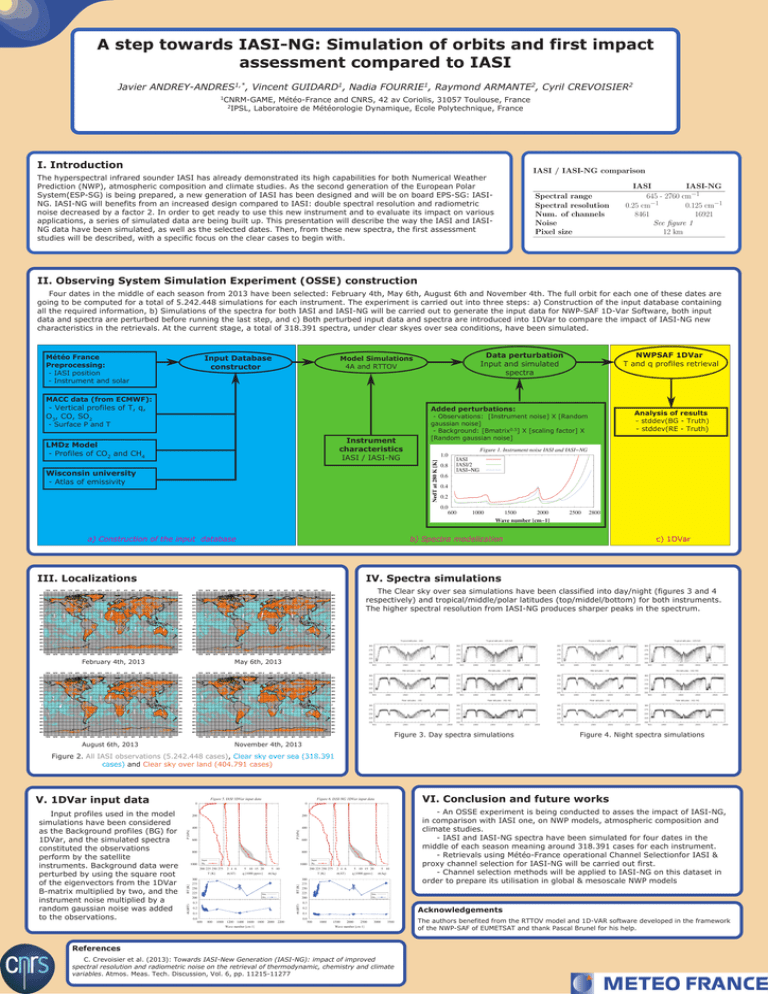A step towards IASING: Simulation of orbits and first impact
advertisement

A step towards IASI­NG: Simulation of orbits and first impact assessment compared to IASI Javier ANDREY­ANDRES1,*, Vincent GUIDARD1, Nadia FOURRIE1, Raymond ARMANTE2, Cyril CREVOISIER2 1 CNRM­GAME, Météo­France and CNRS, 42 av Coriolis, 31057 Toulouse, France 2 IPSL, Laboratoire de Météorologie Dynamique, Ecole Polytechnique, France I. Introduction The hyperspectral infrared sounder IASI has already demonstrated its high capabilities for both Numerical Weather Prediction (NWP), atmospheric composition and climate studies. As the second generation of the European Polar System(ESP­SG) is being prepared, a new generation of IASI has been designed and will be on board EPS­SG: IASI­ NG. IASI­NG will benefits from an increased design compared to IASI: double spectral resolution and radiometric noise decreased by a factor 2. In order to get ready to use this new instrument and to evaluate its impact on various applications, a series of simulated data are being built up. This presentation will describe the way the IASI and IASI­ NG data have been simulated, as well as the selected dates. Then, from these new spectra, the first assessment studies will be described, with a specific focus on the clear cases to begin with. II. Observing System Simulation Experiment (OSSE) construction Four dates in the middle of each season from 2013 have been selected: February 4th, May 6th, August 6th and November 4th. The full orbit for each one of these dates are going to be computed for a total of 5.242.448 simulations for each instrument. The experiment is carried out into three steps: a) Construction of the input database containing all the required information, b) Simulations of the spectra for both IASI and IASI­NG will be carried out to generate the input data for NWP­SAF 1D­Var Software, both input data and spectra are perturbed before running the last step, and c) Both perturbed input data and spectra are introduced into 1DVar to compare the impact of IASI­NG new characteristics in the retrievals. At the current stage, a total of 318.391 spectra, under clear skyes over sea conditions, have been simulated. Météo France Preprocessing: ­ IASI position ­ Instrument and solar Input Database constructor Model Simulations 4A and RTTOV MACC data (from ECMWF): ­ Vertical profiles of T, q, O3, CO, SO2 Added perturbations: ­ Surface P and T Instrument characteristics IASI / IASI­NG LMDz Model ­ Profiles of CO2 and CH4 Wisconsin university ­ Atlas of emissivity III. Localizations August 6th, 2013 ­ Observations: [Instrument noise] X [Random gaussian noise] ­ Background: [Bmatrix0.5] X [scaling factor] X [Random gaussian noise] b) Spectra modelization a) Construction of the input database February 4th, 2013 NWPSAF 1DVar T and q profiles retrieval Data perturbation Input and simulated spectra Analysis of results ­ stddev(BG ­ Truth) ­ stddev(RE ­ Truth) c) 1DVar IV. Spectra simulations The Clear sky over sea simulations have been classified into day/night (figures 3 and 4 respectively) and tropical/middle/polar latitudes (top/middel/bottom) for both instruments. The higher spectral resolution from IASI­NG produces sharper peaks in the spectrum. May 6th, 2013 November 4th, 2013 Figure 3. Day spectra simulations Figure 4. Night spectra simulations Figure 2. All IASI observations (5.242.448 cases), Clear sky over sea (318.391 cases) and Clear sky over land (404.791 cases) V. 1DVar input data Input profiles used in the model simulations have been considered as the Background profiles (BG) for 1DVar, and the simulated spectra constituted the observations perform by the satellite instruments. Background data were perturbed by using the square root of the eigenvectors from the 1DVar B­matrix multiplied by two, and the instrument noise multiplied by a random gaussian noise was added to the observations. References C. Crevoisier et al. (2013): Towards IASI­New Generation (IASI­NG): impact of improved spectral resolution and radiometric noise on the retrieval of thermodynamic, chemistry and climate variables. Atmos. Meas. Tech. Discussion, Vol. 6, pp. 11215­11277 VI. Conclusion and future works ­ An OSSE experiment is being conducted to asses the impact of IASI­NG, in comparison with IASI one, on NWP models, atmospheric composition and climate studies. ­ IASI and IASI­NG spectra have been simulated for four dates in the middle of each season meaning around 318.391 cases for each instrument. ­ Retrievals using Météo­France operational Channel Selectionfor IASI & proxy channel selection for IASI­NG will be carried out first. ­ Channel selection methods will be applied to IASI­NG on this dataset in order to prepare its utilisation in global & mesoscale NWP models Acknowledgements The authors benefited from the RTTOV model and 1D­VAR software developed in the framework of the NWP­SAF of EUMETSAT and thank Pascal Brunel for his help.

